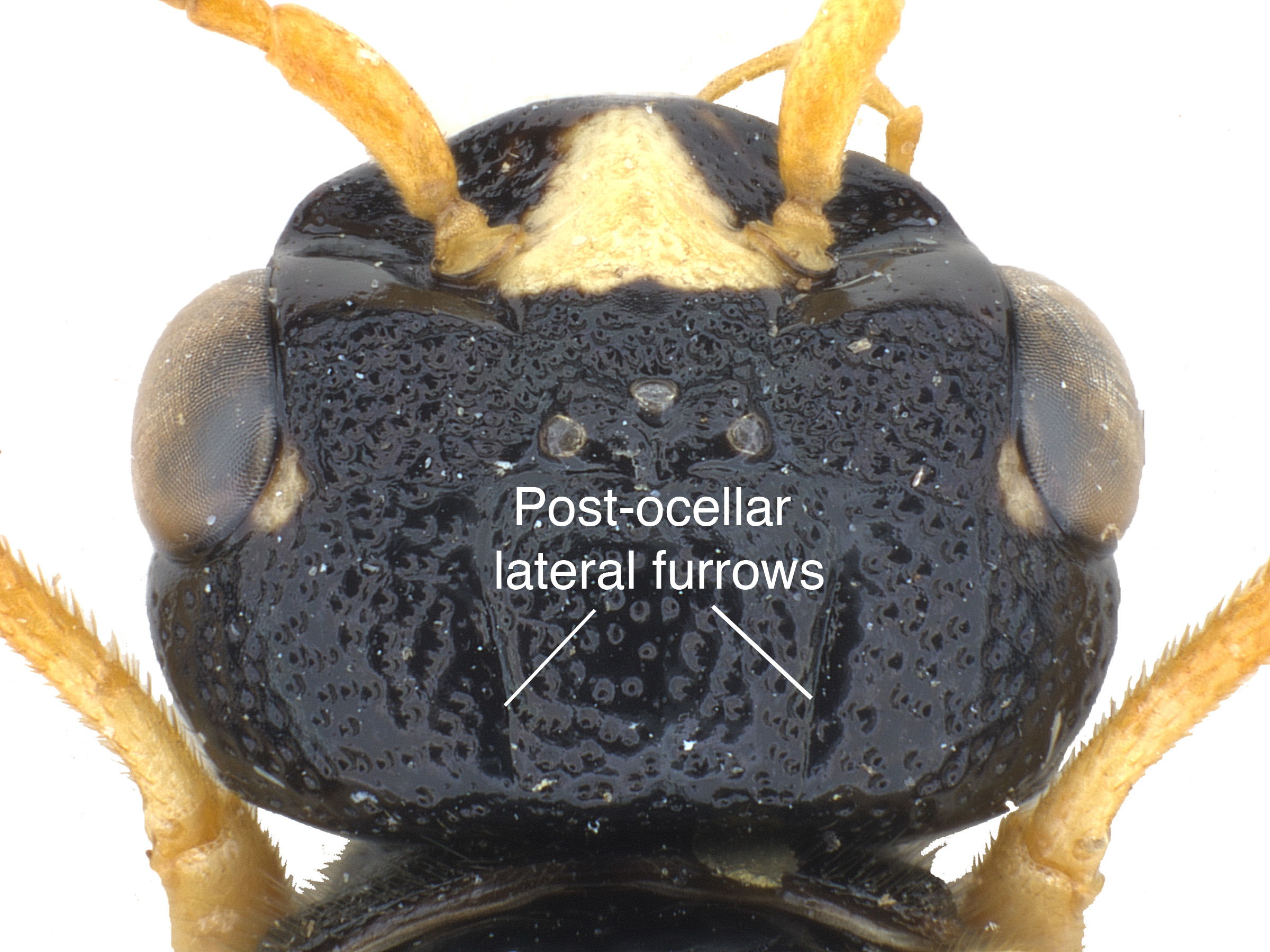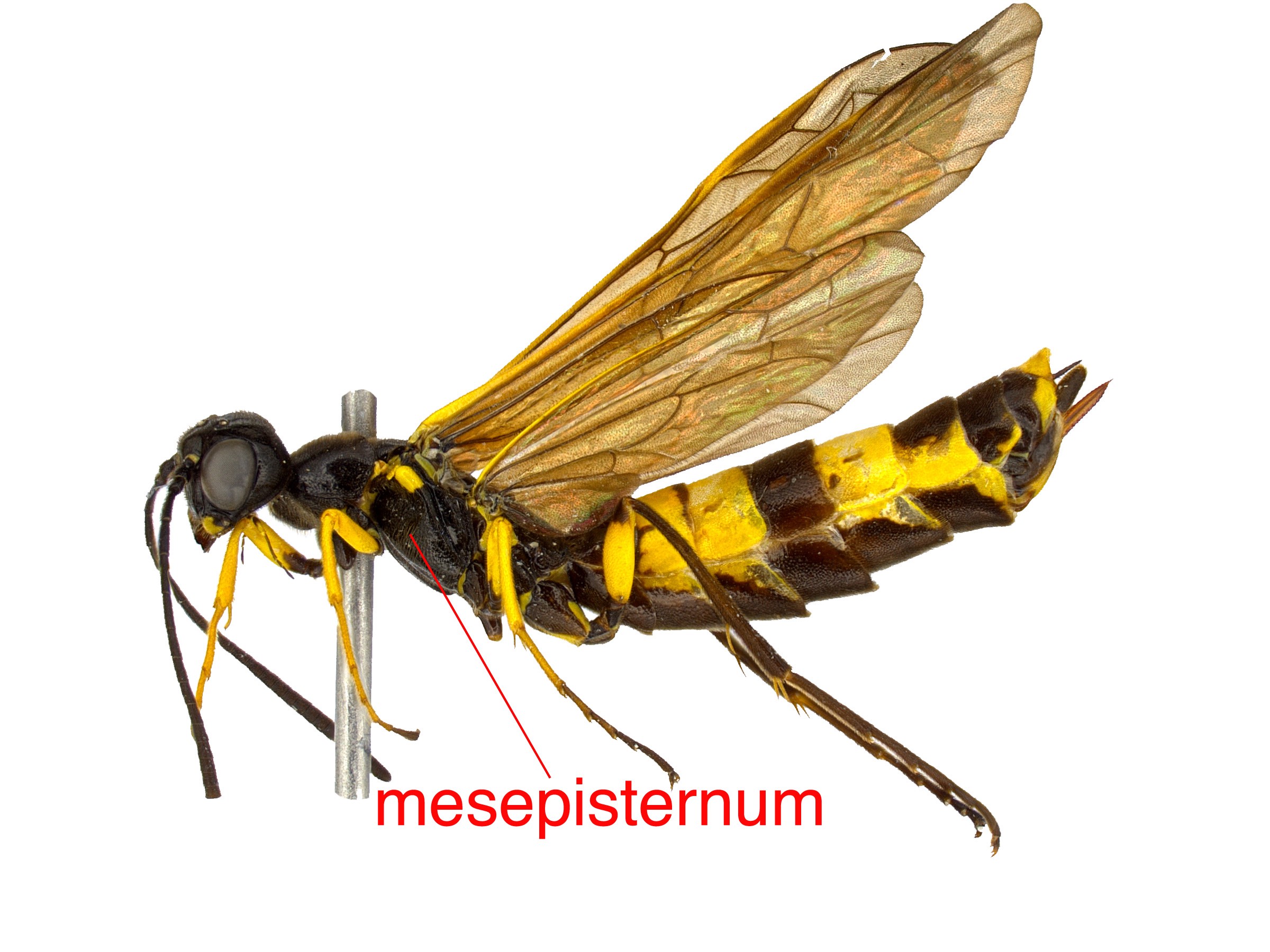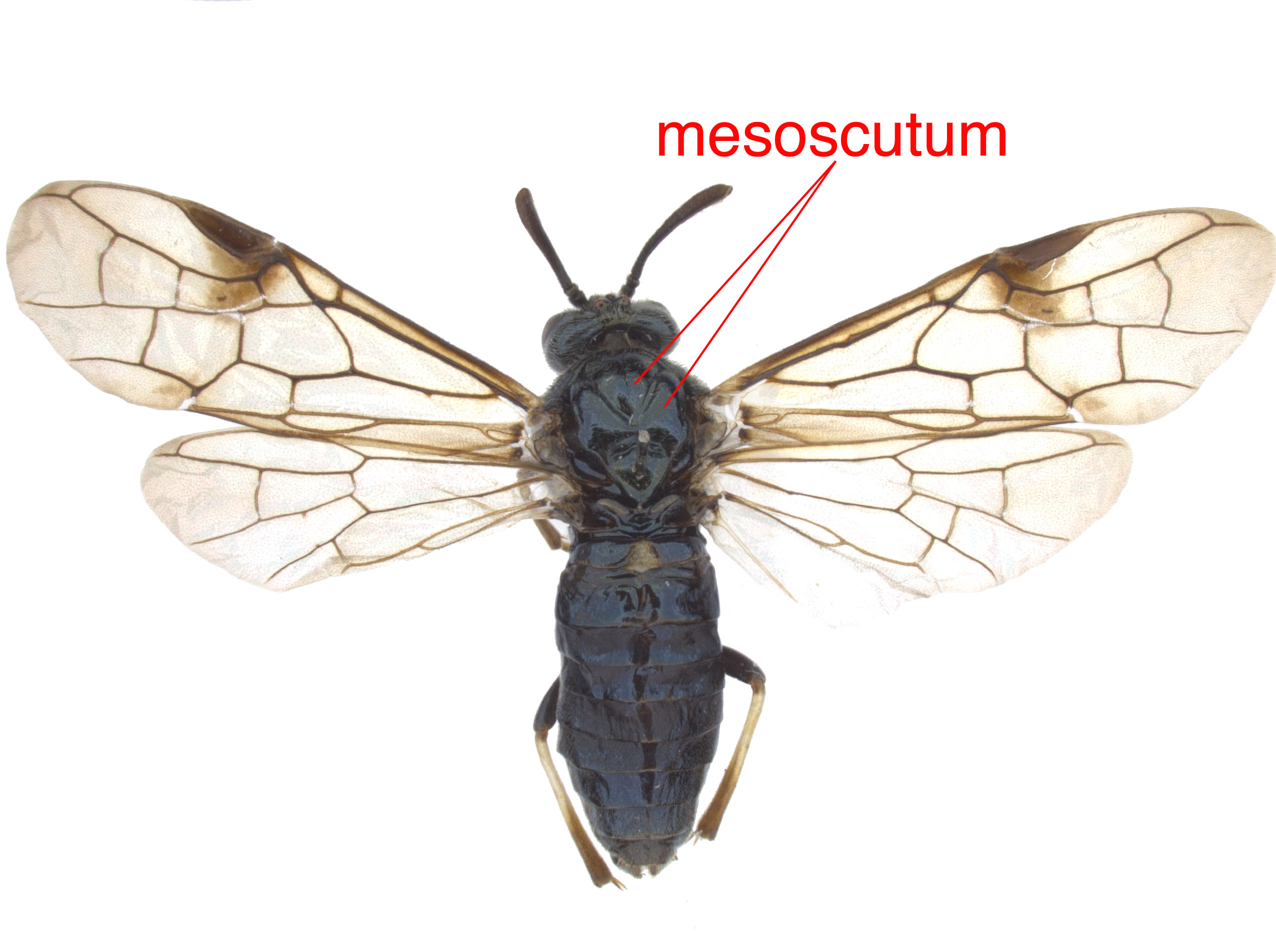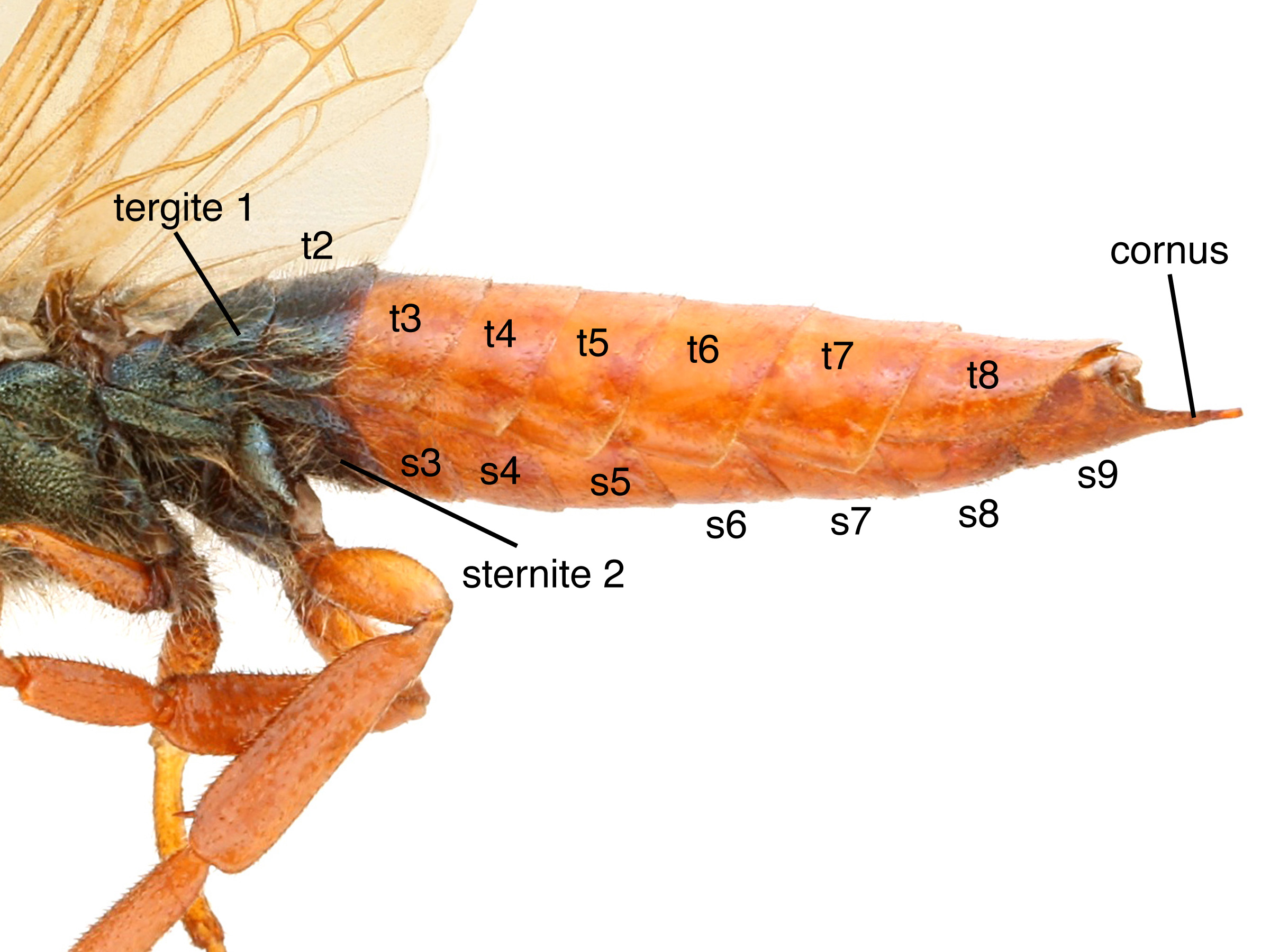Family: Tenthredinidae
Family common name: common sawflies
Subfamily: Selandriinae
Tribe: Strongylogastrini
Genus: Strongylogaster Dahlbom, 1835
Subgenera: none
The Tenthredinidae are the most species-rich family and are found throughout the world, in all continents but Antarctica. They are known as the “common sawflies.” They can generally be recognized by a cylindrical body and long, segmented antennaeantenna:
the sensory organ emerging from the front of the head, usually between the compound eyes and above the clypeus; includes the flagellum, scape and pedicel
 . Otherwise, they come in a variety of colors, sizes, and forms (Goulet 1992Goulet 1992:
. Otherwise, they come in a variety of colors, sizes, and forms (Goulet 1992Goulet 1992:
Goulet H. 1992. The genera and subgenera of the sawflies of Canada and Alaska: Hymenoptera. Symphyta. The insects and arachnids of Canada. Part 20. Agriculture Canada Publication.).
Sawflies in the Selandriinae subfamily are relatively small and slender. The range of Selandriinae is worldwide; it occurs on all continents except Antarctica (Goulet 1992Goulet 1992:
Goulet H. 1992. The genera and subgenera of the sawflies of Canada and Alaska: Hymenoptera. Symphyta. The insects and arachnids of Canada. Part 20. Agriculture Canada Publication.). It is the most common and diverse group of tenthredinids in tropical regions, particularly in Central America, South America, and Southeast Asia (Smith 1969eSmith 1969e:
Smith DR. 1969e. Nearctic Sawflies. II. Selandriinae: Adults (Hymenoptera: Tenthredinidae). Technical Bulletin, U.S. Department of Agriculture 1398: 1-48.). Selandriinae contains the only known sawflies that feed on non-vascular plants, specifically ferns (Smith et al. 2013Smith et al. 2013:
Smith DR, Janzen DH and Hallwachs W. 2013. Food plants and life histories of sawflies of the families Argidae and Tenthredinidae (Hymenoptera) in Costa Rica, a supplement. Journal of Hymenoptera Research 35: 17-31. https://doi.org/10.3897/JHR.35.5496).The subfamily can be distinguished from other subfamilies by wing venationvenation:
the network of veins on a wing
(Goulet 1992Goulet 1992:
Goulet H. 1992. The genera and subgenera of the sawflies of Canada and Alaska: Hymenoptera. Symphyta. The insects and arachnids of Canada. Part 20. Agriculture Canada Publication.).
Strongylogaster are medium-sized, about 7 mm in length, and generally black, white, and orange. The genus is fern-feeding (Smith 1969eSmith 1969e:
Smith DR. 1969e. Nearctic Sawflies. II. Selandriinae: Adults (Hymenoptera: Tenthredinidae). Technical Bulletin, U.S. Department of Agriculture 1398: 1-48.).
There are 55 described extantextant:
in existence; opposite of extinct
species worldwide. Twelve occur in North America (Taeger et al. 2010Taeger et al. 2010:
Taeger A, Blank SM, and Liston AD. 2010. World Catalog of Symphyta (Hymenoptera). Zootaxa 2580: 1-1064.).
A key to NearcticNearctic:
describing the region of the Northern Hemisphere that includes North America south through northern Mexico
 species is included in Smith 1969eSmith 1969e:
species is included in Smith 1969eSmith 1969e:
Smith DR. 1969e. Nearctic Sawflies. II. Selandriinae: Adults (Hymenoptera: Tenthredinidae). Technical Bulletin, U.S. Department of Agriculture 1398: 1-48..
Subfamily characters
 vein Rs+M curved near intersection with veinvein:
vein Rs+M curved near intersection with veinvein: Sc+R (Smith 1969eSmith 1969e:
Sc+R (Smith 1969eSmith 1969e: veins M and m-cu about parallel (Smith 1969eSmith 1969e:
veins M and m-cu about parallel (Smith 1969eSmith 1969e: vein 2r-m present (Goulet 1992Goulet 1992:
vein 2r-m present (Goulet 1992Goulet 1992:Genus characters
 shallowly to deeply notched (Smith 1969eSmith 1969e:
shallowly to deeply notched (Smith 1969eSmith 1969e: wider than long; disc-like (Smith 1969eSmith 1969e:
wider than long; disc-like (Smith 1969eSmith 1969e: present and fairly straight, not V-shaped (Goulet 1992Goulet 1992:
present and fairly straight, not V-shaped (Goulet 1992Goulet 1992: vein M meeting Sc+R at intersection of Rs+M and Sc+R (Smith 1969eSmith 1969e:
vein M meeting Sc+R at intersection of Rs+M and Sc+R (Smith 1969eSmith 1969e: (Goulet 1992Goulet 1992:
(Goulet 1992Goulet 1992: median lobe with setaeseta:
median lobe with setaeseta: wide medially, with narrow membranous area (Goulet 1992Goulet 1992:
wide medially, with narrow membranous area (Goulet 1992Goulet 1992:Strongylogaster can be confused with similar species in the subfamily Selandriinae or tribe Strongylogastrini. It can be distinguished from most other genera by the narrow median lobe of the mesoscutummesoscutum:
the central and dorsal portion of the thorax between the scutellum and postnotum
 , and from closely related Thrinax by the length of the pedicelpedicel:
, and from closely related Thrinax by the length of the pedicelpedicel:
the second antennal segment, between the scape and flagellum
 and the setaeseta:
and the setaeseta:
hair-like structure
on the median lobe of the mesoscutummesoscutum:
the central and dorsal portion of the thorax between the scutellum and postnotum
 (Smith 1969eSmith 1969e:
(Smith 1969eSmith 1969e:
Smith DR. 1969e. Nearctic Sawflies. II. Selandriinae: Adults (Hymenoptera: Tenthredinidae). Technical Bulletin, U.S. Department of Agriculture 1398: 1-48., Goulet 1992Goulet 1992:
Goulet H. 1992. The genera and subgenera of the sawflies of Canada and Alaska: Hymenoptera. Symphyta. The insects and arachnids of Canada. Part 20. Agriculture Canada Publication.).
none
In North America, Strongylogaster feeds on ferns, including Athyrium filix-femina (common lady fern), Osmunda, Pteridium aquilinum (eagle fern), Thelypteris (maiden fern), Gymnocarpium (oak fern), Woodsia (cliff fern), and Woodwardia (chain fern) (Smith 1969eSmith 1969e:
Smith DR. 1969e. Nearctic Sawflies. II. Selandriinae: Adults (Hymenoptera: Tenthredinidae). Technical Bulletin, U.S. Department of Agriculture 1398: 1-48., Goulet 1992Goulet 1992:
Goulet H. 1992. The genera and subgenera of the sawflies of Canada and Alaska: Hymenoptera. Symphyta. The insects and arachnids of Canada. Part 20. Agriculture Canada Publication.).
Specific biology of this genus in North America is not known (Smith 1969eSmith 1969e:
Smith DR. 1969e. Nearctic Sawflies. II. Selandriinae: Adults (Hymenoptera: Tenthredinidae). Technical Bulletin, U.S. Department of Agriculture 1398: 1-48.). Strongylogater osmundae in Japan is multivoltinemultivoltine:
describing a life cycle with many generations per calendar year
and feeds gregariously as larvaelarva:
the immature stage of holometabolous insects
 (Otsuka 1991Otsuka 1991:
(Otsuka 1991Otsuka 1991:
Otsuka K. 1991. Defoliation to maintain multivoltinism: host regulation by a sawfly Strongylogaster osmundae (Hymenoptera: Tenthredinidae) on osmund fern Osmunda japonica (Dissertation). Kyoto University. https://doi.org/10.11501/3052937).
Strongylogaster lineata larvaelarva:
the immature stage of holometabolous insects
 in Europe have defensive behaviors to limit predaceous ants that live on bracken fern to feed on the fern's extra-floral nectaries. When a larvalarva:
in Europe have defensive behaviors to limit predaceous ants that live on bracken fern to feed on the fern's extra-floral nectaries. When a larvalarva:
the immature stage of holometabolous insects
 is first cut by an attacking ant, it bleeds out hemolymphhemolymph:
is first cut by an attacking ant, it bleeds out hemolymphhemolymph:
the "blood" of an insect, a fluid plasma containing nucleated cells
that is extremely sticky and distasteful to the ants. The larvaelarva:
the immature stage of holometabolous insects
 usually can heal after the initial attack, and the associated ants do not return (Heads and Lawton 1985Heads and Lawton 1985:
usually can heal after the initial attack, and the associated ants do not return (Heads and Lawton 1985Heads and Lawton 1985:
Heads PA and Lawton JH. 1985. Bracken, ants, and extrafloral nectaries. III. How insect herbivores avoid ant predation. Ecological Entomology 10: 29-42.).
World: This genus is known from North America, South America in Brazil, Ecuador, and Peru, Europe in the United Kingdom, and in Japan and China (Enderlein 1920Enderlein 1920:
Enderlein G. 1920. Symphytologica II. zur kenntnis der Tenthrediniden. Sitzungsberichte der Gesellschaft Naturforschender Freunde zu Berlin 9 (9): 347-374., Smith 1969eSmith 1969e:
Smith DR. 1969e. Nearctic Sawflies. II. Selandriinae: Adults (Hymenoptera: Tenthredinidae). Technical Bulletin, U.S. Department of Agriculture 1398: 1-48., Smith and Naito 1995Smith and Naito 1995:
Smith DR and Naito T. 1995. A new species of Strongylogaster (Hymenoptera: Tenthredinidae) from North America. Entomological News 106 (2): 57-60., Taeger et al. 2010Taeger et al. 2010:
Taeger A, Blank SM, and Liston AD. 2010. World Catalog of Symphyta (Hymenoptera). Zootaxa 2580: 1-1064.).
North America: Strongylogaster is common in the eastern United States and Canada west through the Rocky Mountains into Idaho, Washington, and British Columbia (Smith 1969eSmith 1969e:
Smith DR. 1969e. Nearctic Sawflies. II. Selandriinae: Adults (Hymenoptera: Tenthredinidae). Technical Bulletin, U.S. Department of Agriculture 1398: 1-48.). One species, S. panamensis, is known only from Panama (Dalla Torre 1894Dalla Torre 1894:
Dalla Torre KW. 1894. Catalogus Hymenopterorum hucusque descriptorum systematicus et synonymicus. Vol. 1: Tenthredinidae incl. Uroceridae (Phyllophaga amp; Xylophaga). Sumptibus Guilelmi Engelmann pp. 1-459.).
Map data from: GBIF.org (29 October 2019) GBIF Occurrence Download Strongylogaster
Details about data used for maps can be found here.